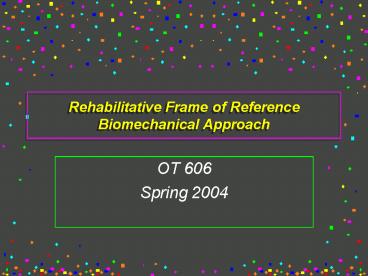Rehabilitative Frame of Reference Biomechanical Approach - PowerPoint PPT Presentation
1 / 18
Title:
Rehabilitative Frame of Reference Biomechanical Approach
Description:
6. High-level endurance. Biomechanical Frame of Reference. Assumptions ... 2. After ROM, strength, and endurance are regained, the client will ... – PowerPoint PPT presentation
Number of Views:9975
Avg rating:3.0/5.0
Title: Rehabilitative Frame of Reference Biomechanical Approach
1
Rehabilitative Frame of ReferenceBiomechanical
Approach
- OT 606
- Spring 2004
2
Rehabilitative Frame of Reference
- Philosophy To enable a person with a physical or
mental disability or chronic illness to achieve
maximum function in the performance of his or her
daily activities (p.538) - Based on medical sciences, physical sciences,
social sciences.
3
Rehabilitation Frame of Reference
- Rehabilitation The process of helping a person
perform competently in his or her social roles
and daily activities (p.538). - Focus compensatory techniques,
adaptive/assistive devices, environmental
modifications
4
Rehabilitative Frame of Reference Assumptions
- 1. Through the use of compensation strategies and
techniques an individual can restore independence
when the underlying impairment cannot be
remediated. - 2. A persons level of motivation affects the
extent to which an individual regains
independence - 3. Environments in which daily activities are
performed influence a persons motivation for
independence.
5
Rehabilitative Frame of Reference Assumptions
- 4. Rehabilitation involves the teaching-learning
process. Therefore, cognitive skills are needed
to learn and apply compensatory strategies.
Motivation enables the person to participate
fully in the teaching-learning process. - 5. Clinical reasoning, used by the practitioner,
begins with the individual's functional
capabilities, then moves to the environments in
which the person will function, and then to the
types of compensatory strategies the person needs
to use his or her capacities.
6
Rehabilitative Frame of Reference Evaluation
- Evaluation assesses clients functioning in self
care, work, and leisure. - Evaluation involves
- Observation
- Interviews of clients daily living priorities
- Client self-report re ability to perform tasks
7
Rehabilitative Frame of Reference Evaluation
- Therapist focuses on
- 1. characteristics of environments in which
client functions - 2. equipment and clients economic resources
- 3. level of assistance/supervision available for
client - 4. developmental expectations for client
performance - 5. absent or limited performance components
(skills abilities). (p.539)
8
Rehabilitative Frame of Reference Mechanisms for
Change
- Assumption is that clients impairment is stable
- Can alter function through compensatory
strategies and adaptive equipment - Therapist teaches client new ways to perform
ADLs.
9
Rehabilitative Frame of Reference Change in
Function
- Client must
- Be motivated
- Be able to use compensatory strategies and
- have underlying perception/cognition to do that
- Environment must
- Have necessary
- equipment
- Objects
- Support and feedback systems
10
Rehabilitative Frame of Reference Treatment
- Includes purposeful activities
- Daily living
- Work
- Leisure
- Compensatory strategies
- Practice of these tasks and strategies
- Collaboration with client important
- Client must cooperate
- Therapist must be creative in problem-solving
11
Rehabilitative Frame of Reference Strengths and
Limitations
- Strengths
- Long successful history
- Focus on client capabilities, and important ADLs
- Client centered
- Evaluates Clients interests, roles, resources,
environments, support systems - Holistic perspective
- Weaknesses
- Some ADL instruments lack validity/reliability
testing outcomes research is limited - Does not address unmotivated client
- Does not offer alternative approaches if
compensatory strategies ineffective or client
unable to learn new ways of doing - Does not address psychosocial needs of clients
- Linked to medical model
12
Biomechanical Frame of Reference Domains of
concern
- 1. Structural stability
- 2. low-level endurance
- 3. Edema control
- 4. Passive range of motion (PROM)
- 5. Strength
- 6. High-level endurance
13
Biomechanical Frame of Reference Assumptions
- 1. purposeful activities can be used to treat
loss of ROM, strength, and endurance - 2. After ROM, strength, and endurance are
regained, the client will automatically regain
function. - 3. The principle of rest and stress first the
body must rest to heal itself then structures
must be stressed to regain range, strength,
endurance - 4. The biomechanical frame of reference is best
suited for clients with an intact central nervous
system because clients must be able to perform
smooth, isolated movements (p.541).
14
Biomechanical Frame of Reference - Evaluation
- Domains of concern
- 1. Structural stability
- 2. low-level endurance
- 3. Edema control
- 4. Passive range of motion (PROM)
- 5. Strength
- 6. High-level endurance
- Evaluations
- 1. X-ray (Physician)
- 2. Cardiac step charts, recording time pt can
tolerate sedentary activity - 3. Volumetry
- 4. Goniometry
- 5. Manual muscle tests, palpation, clinical
observation - 6. Number of reps or duration pt. can perform
activity.
15
Biomechanical Frame of Reference Client
Practitioner Interaction
- Therapist must explain connection between
clients deficit and biomechanical goal and
functional outcome. - in writing for reimbursement purposes and
- verbally to client because treatment can be
painful
16
Biomechanical Approach -Strengths and Limitations
- Strengths
- Easy to write measurable goals quantifiable
- Oldest form of treatment for physical
disabilities
- Weaknesses
- Purposeful activities much more effective than
rote exercise - Does not address pain, loss of sensation,
incoordination
17
Rehabilitative Frame of ReferenceBiomechanical
Approach
- Whose Life is it Anyway?
18
Questions for Whose Life is it Anyway?
- 1. Which approach is more appropriate for the
main character rehabilitative or biomechanical? - 2. What would you suggest an OT do to help this
person transition from hospital to home
environment? - 3. Treatment activities would you suggest?
- 4. What are some barriers to treatment being
successful? - 5. What are some resources the main charcater
has? - 6. If the main character had more use of his
upper extremities and trunk, what else could you
have him do? Which approach would you use?






























